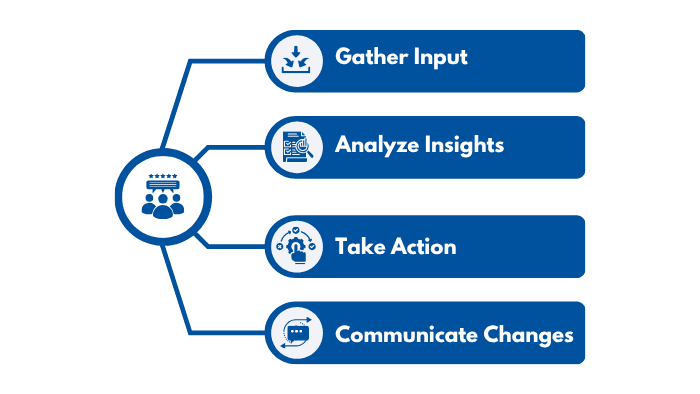

Feedback Loop: What It Is, How It Works, and Why It Matters for Growth
In today’s fast-moving world, the ability to learn and adapt quickly separates successful businesses from those that fall behind. At the heart of this adaptability is the feedback loop a process where results are measured, analyzed, and then fed back into the system to improve future outcomes. From biological systems that regulate our bodies, to business strategies that keep customers loyal, feedback loops are everywhere. But what exactly are they, and how can you use them to build stronger systems?
What is the meaning of the feedback loop?
The true meaning of a feedback loop lies in its ability to create continuous learning.
It’s not about reacting once and moving on; it’s about establishing a system that automatically learns from past experiences. There are two main types of loops that explain how systems behave: the positive feedback loop and the negative feedback loop.
A positive feedback loop amplifies what’s working. In business, it may take the form of a referral program: a satisfied customer is referred by a friend, a friend by another, etc.
Conversely, negative feedback loop is concerned with stability. As an illustration, a call center experiencing a lengthy waiting time will automatically divert the customers to chat bots or reserve employees to maintain service levels at normal. Both of them are important: positive loops make you develop, and negative loops make you remain stable.
How does a feedback loop work in practice?
In its simplest form, a feedback loop consists of four steps, including the gathering of input, the analysis of insights, action on findings, and the loop closure, which involves communication of the changes.
In the case of a customer feedback loop, this could be in the form of sending post purchase surveys, revealing that shipping delays are annoying buyers, fixing the logistics and then notifying customers that their feedback directly contributed to faster deliveries.
Repetition is the power of a feedback loop. One round improves the one before it is resulting in improved products, improved processes and relationships. Without the final phase of the process involving communicating what changed the loop is not complete and the stakeholders will cease to give feedback in future.

What best describes a feedback loop?
The feedback loop can be defined as the recurring cycle in which the outputs are the subsequent input.
Example: a business that gathers customer survey data: whatever the customer is saying is the input, analyzing the patterns in the responses is the analysis, fixing the pain points or adding features is the action, and the cycle repeats where the business explains the changes to the customers. This does not end it repeating and perfecting itself.
The same can be stated in non-business as well. In technology algorithms optimize themselves based on their feedback. At its simplest, a feedback loop is about listening, learning, and adjusting over and over again.
What is a feedback looper?
The person or tool responsible for keeping the cycle alive is often called a feedback looper. This could be a product manager that will make sure that feedback by the users is translated into features, a customer success manager that keeps track of satisfaction, or even automated software that will route and analyze feedback to scale. Unless someone, or something, is actively working to feed some insights into the system, feedback runs the risk of being gathered and never acted upon.
Great loopers do not simply collect information. They give more importance to high impact insights, have defined owners to be followed up, and report the results to the stakeholders. That is, they make sure that the loop does not exist but flourishes.
What is a positive feedback loop?
Positive feedback loops and negative feedback loops can manifest themselves in various ways in business.
Take an example of a loyalty program in the retail industry. Each purchase gets points, and this motivates more purchases, thus, resulting in more points, and this cycle of repeat purchases. It is a typical positive loop because it increases an action that is good for both the customer and the company.
What is a negative feedback loop?
Conversely, a negative feedback loop is enacted when something requires fixing.
Indicatively, when the customer service wait time begins to increase, the system automatically increases the number of agents or provides self service. After normalization of the wait times, the system goes back to normal staffing. This balancing effect averts the crisis and makes sure that customers still get a steady service. What is important to know is that both a positive loop (continuous growth due to success) and a negative loop (risk management) are essential to businesses.
How can you create a customer feedback loop that actually works?
A customer feedback loop is one of the most powerful tools any business can use. It starts by actively gathering input through surveys, interviews, or monitoring online reviews. But collection is just the beginning. The feedback has to be analyzed carefully so recurring pain points and opportunities stand out.
The second is action either by correcting an imperfection in a product or polishing policies or launching a new feature that is required by customers. Last but not least; the loop needs to be closed. This involves sending back feedback to the customers with the help of such messages as “You said”, “we did”. The loop helps to build trust and make the customers more inclined to leave feedback in future. This cycle does not only enhance the products and services over time, but it enhances the customer relationships and loyalty.

Why feedback loops matter more than ever?
The business environment in 2025 is faster and more competitive than ever. Customers expect personalization, rapid responses, and clear evidence that their voices are heard. Without a reliable customer feedback loop, businesses risk falling out of touch with what customers truly value. At the same time, positive feedback loops can drive viral growth through referrals and loyalty, while negative feedback loops keep systems stable as organizations scale.
Companies that learn to design and balance these loops don’t just survive they thrive. A feedback loop turns raw data and customer comments into actionable insight, creating a culture of continuous improvement. And in an age where experiences matter as much as products, that culture may be the single biggest competitive advantage.
Conclusion: Turning feedback into growth
A feedback loop is not an only technical notion, but it is a mentality. It is the assumption that the process of improvement is never ending and that the ability to listen is equally significant as taking actions. By learning how to use positive feedback loops to stabilize, negative feedback loops to stabilize, and the creation of transparent customer feedback loops, one will be able to convert every bit of input into a growth engine.
It is only this easy; systems that listen, learn and adapt will always work better than those that do not. Establish your feedback loop now, and you will be coming up with a strategy that stands the test of time tomorrow.

Author



